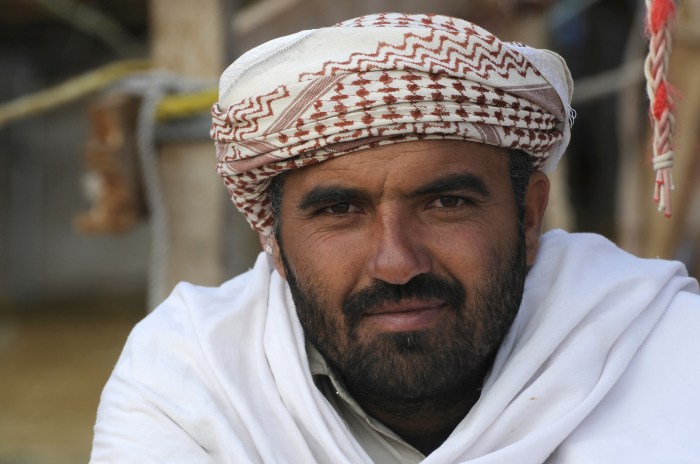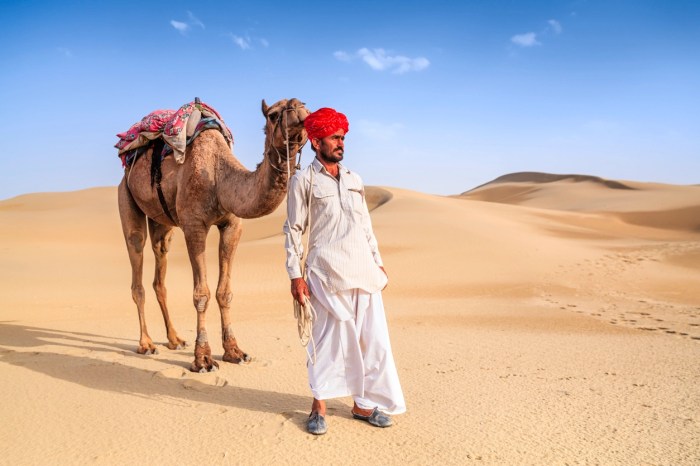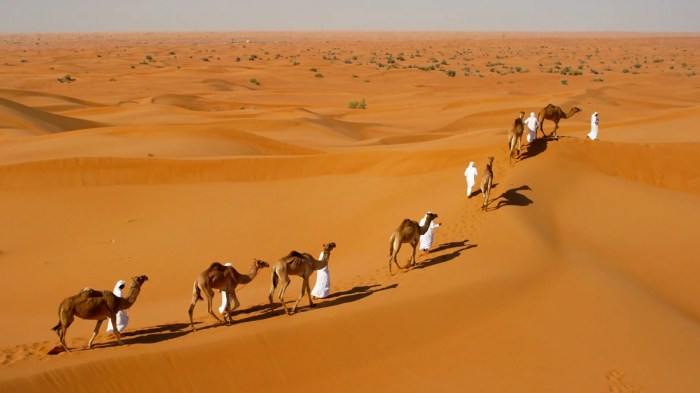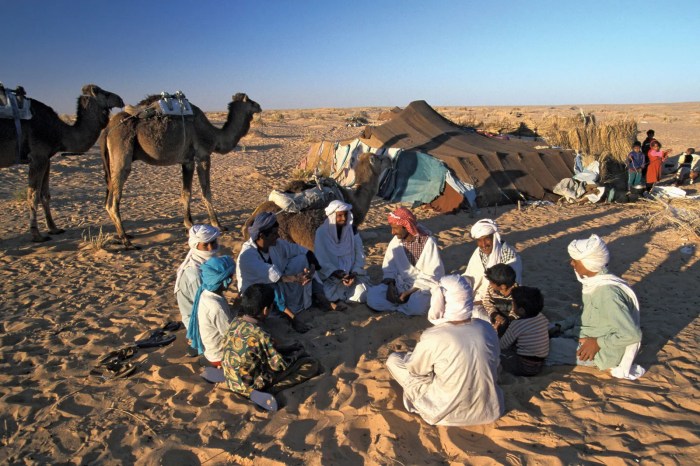The Bedouin, a nomadic people of the Arabian Peninsula, have captured the imagination of the world with their unique culture and resilience. From their rich heritage to their adaptation to the harsh desert environment, the Bedouin embody a fascinating chapter in human history.
Their nomadic lifestyle, deep understanding of the desert ecosystem, and historical significance make them a captivating subject of study and admiration.
Cultural Heritage
The Bedouin people, known for their nomadic lifestyle, have a rich cultural heritage that has been passed down through generations. Their traditions and customs are deeply rooted in their desert environment and reflect their strong sense of community and family.
Social Structure and Family Values
Bedouin society is organized into tribes, each with its own leader or sheikh. The sheikh is responsible for maintaining order and resolving disputes within the tribe. Family is central to Bedouin culture, and extended families often live together in large tents or houses. Children are highly valued and play an important role in the community.
Traditional Arts and Crafts, Bedouin
The Bedouin are skilled artisans, known for their traditional crafts such as weaving, embroidery, and jewelry making. Their textiles are often decorated with intricate patterns and colors, reflecting their desert surroundings. Bedouin jewelry is typically made of silver and often incorporates semi-precious stones.
Music and Dance
Music and dance play a significant role in Bedouin culture. Traditional Bedouin music is often performed on instruments such as the oud, the rababa, and the mizmar. Bedouin dance is characterized by its lively rhythms and energetic movements.
Nomadic Lifestyle

The Bedouin have historically been a nomadic people, adapting their lifestyle to the harsh desert environment. Their nomadic lifestyle has allowed them to survive and thrive in a region where resources are scarce and the climate is unforgiving.
The Bedouin’s traditional practices of animal husbandry and herding have played a vital role in their nomadic lifestyle. They have developed specialized knowledge and skills in raising and managing livestock, which has enabled them to sustain themselves in the desert. The Bedouin’s ability to adapt to the changing seasons and find water sources has also been essential to their survival.
The Bedouin, nomadic tribes of the Arabian Desert, have a rich cultural heritage that has been passed down through generations. Their traditions and customs have remained largely unchanged for centuries, despite the changing world around them. One of the most popular tourist destinations in the world, barcelona beach , is a stark contrast to the Bedouin’s traditional lifestyle.
Yet, the Bedouin’s resilience and adaptability have allowed them to maintain their unique culture while embracing modern conveniences.
Animal Husbandry and Herding
Animal husbandry is a central part of the Bedouin lifestyle. The Bedouin traditionally raise sheep, goats, camels, and horses. These animals provide them with food, clothing, and transportation. The Bedouin have developed specialized techniques for managing their livestock, including selective breeding and grazing practices.
The Bedouin’s herding practices are also adapted to the desert environment. They often use camels to transport their herds over long distances in search of water and grazing land. The Bedouin also use traditional knowledge of the desert to find water sources and avoid areas that are prone to drought.
Environmental Resilience

Bedouins possess an intimate understanding of the desert ecosystem, having developed traditional knowledge and practices that enable them to thrive in this challenging environment.
Managing Natural Resources
- Water Conservation: Bedouins have devised ingenious methods for collecting and storing rainwater, such as building underground cisterns and using condensation techniques.
- Sustainable Grazing: They practice rotational grazing to prevent overgrazing and ensure the long-term health of the desert’s vegetation.
- Wildlife Protection: Bedouins have traditionally respected and protected wildlife, recognizing their role in maintaining the ecosystem’s balance.
Adaptation to Climate Change
- Nomadic Lifestyle: The Bedouin’s nomadic lifestyle allows them to move in response to changing climate patterns, seeking areas with water and grazing land.
- Desert Knowledge: Their extensive knowledge of the desert enables them to identify safe travel routes and predict weather conditions.
- Resilient Structures: Bedouin tents and other structures are designed to withstand harsh desert conditions, providing shelter from extreme temperatures and sandstorms.
Historical Significance

The Bedouins, with their rich history and nomadic lifestyle, played a significant role in shaping the historical landscape of the Arabian Peninsula.
Their involvement in trade, warfare, and cultural exchange left an enduring legacy on the region and beyond.
Trade and Commerce
The Bedouins were instrumental in facilitating trade across the vast and unforgiving desert terrain of the Arabian Peninsula.
The Bedouin, a nomadic Arab people, have a rich cultural heritage that spans centuries. Their traditional way of life has been influenced by the harsh desert environment they inhabit. In recent times, some Bedouin have settled in towns and cities, including Berwick , where they have adapted to a more modern lifestyle while still maintaining their cultural identity.
The Bedouin continue to play an important role in the region, contributing to its cultural and economic diversity.
They served as intermediaries, connecting distant settlements and civilizations, and played a crucial role in the exchange of goods, ideas, and technologies.
Warfare and Conflict
Bedouin tribes were renowned for their fierce warriors and skilled horsemen.
Their knowledge of the desert and their ability to wage effective guerrilla warfare made them formidable opponents.
They often engaged in conflicts with neighboring tribes, empires, and invading forces, shaping the political and military landscape of the region.
Cultural Exchange
As nomads, the Bedouins carried their traditions, customs, and language across the Arabian Peninsula.
For a memorable beach holiday, a packing list is essential. Here’s a beach holiday packing list to help you pack everything you need. The Bedouins, nomadic people who live in the deserts of the Middle East, are known for their resilience and adaptability.
Their traditional clothing and accessories are well-suited for the harsh desert environment, and their way of life has inspired many modern-day travelers.
Their interactions with other cultures led to a rich exchange of ideas, beliefs, and practices.
Bedouin poetry, music, and storytelling became an integral part of the region’s cultural heritage, influencing and inspiring generations.
Modern Transformations

The modern world presents both challenges and opportunities for the Bedouin. As the world becomes increasingly interconnected and globalized, Bedouin communities are faced with the need to adapt to new ways of life while preserving their unique culture and traditions.
One of the most significant challenges facing the Bedouin is urbanization. As cities expand and offer new economic opportunities, many Bedouin have left their traditional nomadic lifestyle to settle in urban areas. This has led to a number of social and cultural changes, as Bedouin communities have had to adapt to new ways of living and working.
Education and Technology
Education is another important factor in the modern transformation of the Bedouin. In the past, Bedouin children were often not able to attend school, but today there are many opportunities for them to receive an education. This has led to a number of positive changes, as Bedouin children are now able to learn new skills and knowledge that can help them to improve their lives.
Technology has also played a major role in the modern transformation of the Bedouin. Bedouin communities now have access to a wide range of technologies, such as mobile phones, computers, and the internet. This has helped them to stay connected with each other and with the rest of the world, and it has also made it easier for them to access information and services.
Preserving Bedouin Culture
Despite the challenges of urbanization and globalization, there are many Bedouin communities that are working to preserve their unique culture and traditions. These communities are often located in remote areas, and they have been able to maintain their traditional way of life. They continue to practice traditional crafts, such as weaving and pottery, and they also celebrate traditional festivals and ceremonies.
There are also a number of organizations that are working to preserve Bedouin culture. These organizations provide support to Bedouin communities, and they also work to raise awareness of Bedouin culture and traditions.
Outcome Summary: Bedouin

As the modern world continues to evolve, the Bedouin face both challenges and opportunities. Preserving their culture while embracing progress is a delicate balance they must navigate. Their story serves as a testament to the resilience of human spirit and the enduring power of tradition.
FAQ Summary
What is the traditional social structure of the Bedouin?
Bedouin society is organized into tribes, each with its own leader or sheikh. Family ties are strong, and extended families often live together in tents or small villages.
How do the Bedouin adapt to the harsh desert environment?
The Bedouin have developed a deep understanding of the desert ecosystem. They use traditional knowledge and practices to manage water resources, find food, and protect themselves from the elements.
What are some of the challenges facing the Bedouin in the modern world?
The Bedouin face challenges such as urbanization, climate change, and the loss of traditional grazing lands. They are also working to preserve their culture and traditions while adapting to the demands of the 21st century.